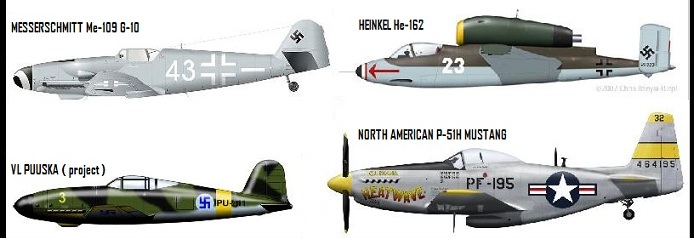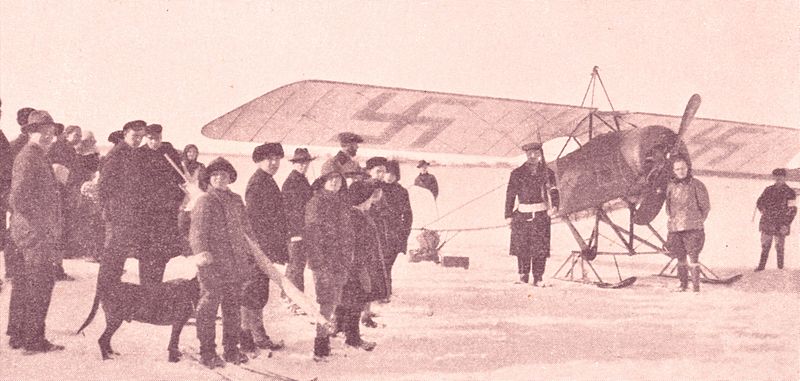VL. (Finnish) pre.1945 projects and prototypes
Last edited:
thanks , than was a variant of Pyörremyrsky : there are not great difference with two airplanes ! Puuska was a little small than Pyörremyrsky and more longineus !Apophenia said:Airman,
VL's Pyörremyrsky (Hurricane) and Puuska (Gust) are related but separate designs.
The Puuska was a lightweight fighter with narrow-track undercarriage (Pyörremyrsky had a wide track gear). Puuska was also quite a bit smaller. Both were powered by German DB605A-1s.
The Ilmavoimat ordered the Puuska in January 1944 but never built (presumably because Bf-109Gs were readily available).
There were two versions of the Puuska design, the PU-411 and PU-412. IIRC, design work started in 1942.
A comparsion of specs
Puuska Pyörremyrsky
Span 9.20 m 10.38 m
Length 7.50 m 9.13 m
Engine DB605A-1 DB605A-1
Max speed 650 km/h 620 km/h
MTOW 2,750 kg 3,310 kg
Ceiling 14,000 m 11,250 m
Armament 2 x LKK/42 2 x LKK/42
1 x MG 151 1 x MG 151
http://wp.scn.ru/en/ww2/f/376/78/0/1
airman said:thanks , than was a variant of Pyörremyrsky : there are not great difference with two airplanes ! Puuska was a little small than Pyörremyrsky and more longineus !Apophenia said:Airman,
http://wp.scn.ru/en/ww2/f/376/78/0/1
Apophenia said:Very nice ... thanks Justo.
Interesting that there is no sign of the twin 12.7mm guns in the Finnish drawings (I wonder: is this a difference between the PU-411 and PU-412 designs?).
IIRC, consideration was also given to larger calibre main gun. Maybe VL thought they could dispense with cowl guns if there was a large enough weapon firing through the spinner?
Faster airspeed and better climb rate than in Bf-109, with the expense of having no armour at all.airman said:by design i suppose that Valmet "Puuska" was more manovrable !
Justo Miranda said:Pyörremyrsky drawings by myself are SOURCE GRADING 5
Plese find attached two Puuska drawings from Keski-Suomen Ilmailumuseo, via Hannu Valtonen
Chicken kana said:They are SIL(Suomen Ilmailuhistoriallinen lehti=Finn Aviationhistorical magazine)http://www.kolumbus.fi/sil/contents.html.In Link Choose Year Chapter In Right.It`s Finn languege Magazine. Valtion Lentokone Tehtaan Historia 2(You find it in Google ) Book You Find Wihuri-Mosquito Drawnings.

Valtion lentokone tehdas=VL
http://en.wikipedia.org/wiki/VL_Humu
http://en.wikipedia.org/wiki/Valtion_lentokonetehdas
Chicken kana said:Justo Miranda said:Pyörremyrsky drawings by myself are SOURCE GRADING 5
Plese find attached two Puuska drawings from Keski-Suomen Ilmailumuseo, via Hannu Valtonen
Pyörremyrsky is non-project. You can see Pyörremyrsky(In english it mean hurricane) in Keski-Suomen Ilmailumuseo.


Apophenia said:I suspect that Juhae is right. DH also had access to high-quality woods from around the world.
Hard to find a substitute for the British Columbia sitka spruce used for Mosquito spars. IIRC, balsa for the plywood cores was sourced from Ecuador.
Apophenia said:Nice profiles topspeed3.
Mod: Should this be merged with VL Finnish pre-1945 projects?
http://www.secretprojects.co.uk/forum/index.php/topic,621.0

topspeed3 said:Apophenia said:I suspect that Juhae is right. DH also had access to high-quality woods from around the world.
Hard to find a substitute for the British Columbia sitka spruce used for Mosquito spars. IIRC, balsa for the plywood cores was sourced from Ecuador.
I doubt that, since also Spruce Goose was build from birch wood as was the finnish plywood. The real problem was the bad availability of the glue...
Apophenia said:Great stuff topspeed3!
topspeed3 said:Apophenia said:I suspect that Juhae is right. DH also had access to high-quality woods from around the world.
Hard to find a substitute for the British Columbia sitka spruce used for Mosquito spars. IIRC, balsa for the plywood cores was sourced from Ecuador.
I doubt that, since also Spruce Goose was build from birch wood as was the finnish plywood. The real problem was the bad availability of the glue...
I didn't make it all that clear but my reference was to the Wihuri as a Mosquito clone. Without access to those more exotic woods, VL has no option but to completely redesign the Mosquito airframe for locally-available woods. 'Do-able', no doubt, but no longer a simple matter of reverse-engineering.
